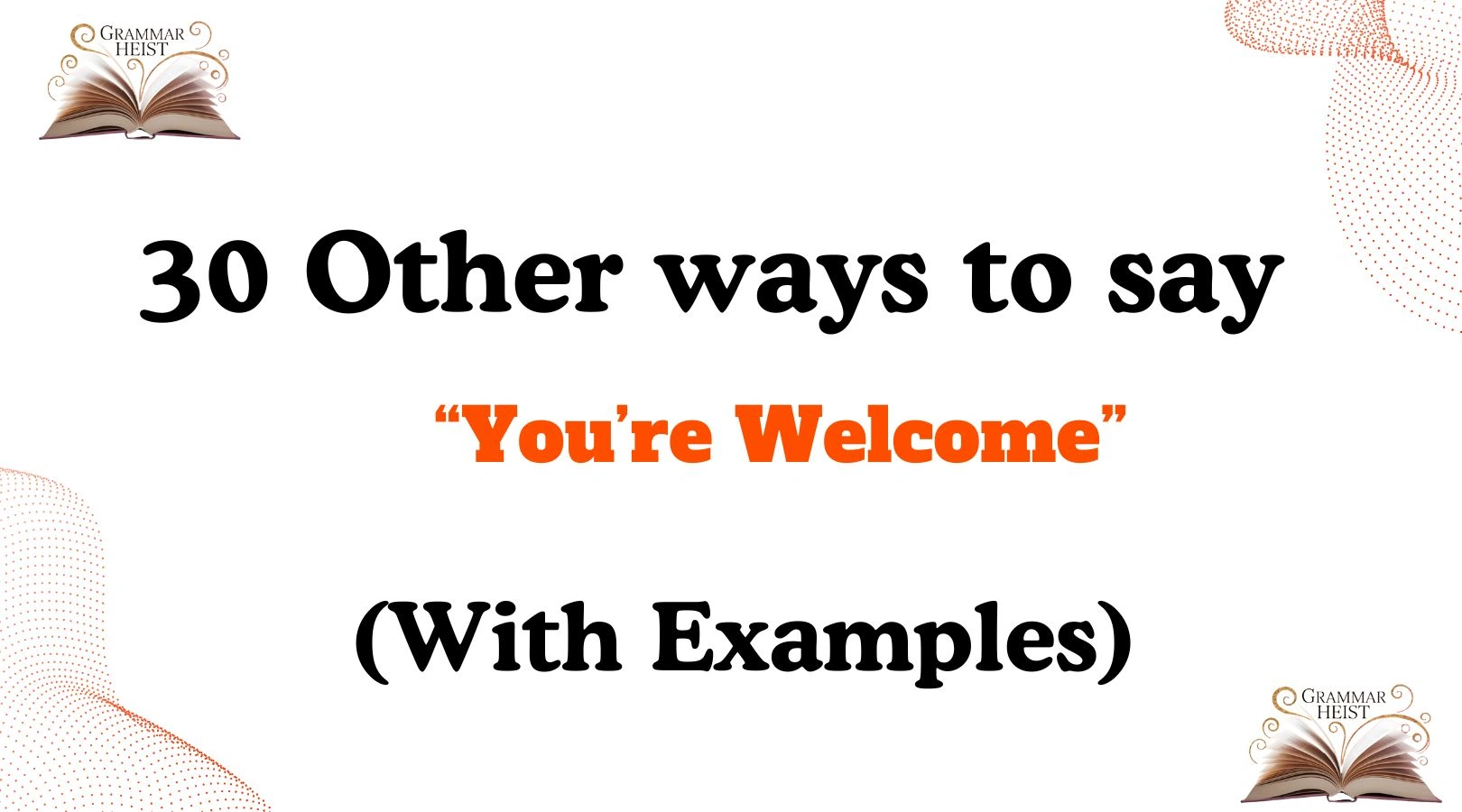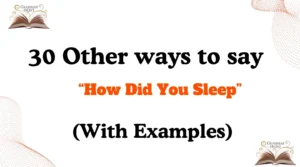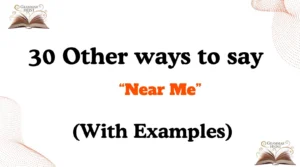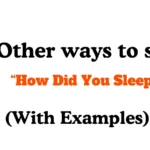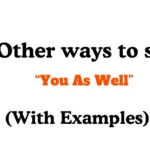Finding other ways to say “you’re welcome” can add a touch of warmth, care, and authenticity to your daily conversations. Whether you’re replying to a friend, colleague, or customer, the right words can make your response feel more personal, polite, and genuine. Using thoughtful alternatives shows empathy and helps you connect with others on a deeper level.
Let’s explore 30 meaningful ways to say “you’re welcome,” each with examples, tone, and explanations to help you express gratitude more naturally.
What Does “You’re Welcome” Mean?
The phrase “you’re welcome” is a polite response used when someone thanks you. It’s a way to acknowledge their gratitude while showing that you’re happy to help. Essentially, it means “It was no trouble” or “I’m glad I could do that for you.”
It’s a simple yet powerful phrase that reflects kindness, humility, and appreciation in communication.
Is It Professional/Polite to Say “You’re Welcome”?
Yes, saying “you’re welcome” is both professional and polite. It’s suitable for formal and informal conversations alike. In business settings, it shows professionalism and respect. In personal moments, it conveys warmth and sincerity.
However, using variety—like “My pleasure” or “Anytime”—can make your communication feel more natural and engaging, especially when you want to sound friendly or heartfelt.
Pros and Cons of Saying “You’re Welcome”
Pros:
- Shows good manners and appreciation.
- Works in almost any situation.
- Sounds respectful and kind.
Cons:
- May sound repetitive if overused.
- Sometimes feels too formal or distant in casual chats.
- Might not fully express warmth or emotion.
Synonyms For “You’re Welcome”
- My Pleasure
- Anytime
- No Problem
- Don’t Mention It
- Glad to Help
- It Was Nothing
- Happy to Help
- You Got It
- Of Course
- Not a Problem
- Sure Thing
- Absolutely
- It’s No Trouble
- No Worries
- It Was a Pleasure
- No Need to Thank Me
- You’re Very Welcome
- That’s Okay
- I Got You
- Happy to Be of Service
- Not at All
- Always Happy to Help
- It’s a Pleasure
- That’s Alright
- It’s Nothing
- Sure
- It Was a Joy
- Always
- That’s What I’m Here For
- No Big Deal
1. My Pleasure
Scenario: Used in both formal and friendly settings when you genuinely enjoyed helping someone.
Examples:
- “Thank you for your help today!” → “My pleasure!”
- “I really appreciate your advice.” → “My pleasure, anytime!”
- “Thanks for picking me up.” → “It was my pleasure.”
Tone: Polite, warm, and sincere.
Explanation: This phrase shows you were genuinely happy to help. It’s often used in customer service or professional conversations but also feels heartfelt in casual moments.
2. Anytime
Scenario: Perfect for friends, colleagues, or customers when you want to show you’re always open to helping again.
Examples:
- “Thanks for fixing the issue.” → “Anytime!”
- “You really saved me there.” → “Anytime, happy to help!”
- “Thanks for the advice.” → “Anytime, you know where to find me!”
Tone: Friendly and approachable.
Explanation: It makes your response sound easygoing and reassuring, as if helping is second nature to you.
3. No Problem
Scenario: Common in casual conversations when you want to sound relaxed and down-to-earth.
Examples:
- “Thanks for lending me your notes.” → “No problem!”
- “Thanks for helping me move.” → “No problem at all!”
- “I appreciate your help.” → “No problem, happy to do it.”
Tone: Informal and friendly.
Explanation: Shows that the favor didn’t inconvenience you. Use it with friends or peers, but avoid it in very formal situations.
4. Don’t Mention It
Scenario: Used when you want to downplay your effort and make the other person feel comfortable.
Examples:
- “Thanks for helping me with that call.” → “Don’t mention it!”
- “I owe you big time.” → “Don’t mention it, it was nothing.”
- “Thanks for being there.” → “Don’t mention it, I’m always here.”
Tone: Humble and caring.
Explanation: It subtly tells the other person not to feel indebted to you—perfect for friends or colleagues who thank you often.
5. Glad to Help
Scenario: Ideal for expressing genuine satisfaction in assisting someone.
Examples:
- “Thanks for your input.” → “Glad to help!”
- “Appreciate your support.” → “I’m glad to help anytime!”
- “You saved me!” → “Glad to help, truly.”
Tone: Sincere and professional.
Explanation: A neutral yet warm option that works well in emails, workplaces, or everyday conversations.
6. It Was Nothing
Scenario: Used when the task was small and you don’t want the other person to feel overly grateful.
Examples:
- “Thanks for covering for me.” → “It was nothing!”
- “Thanks for helping with my report.” → “Oh, it was nothing, really.”
- “I appreciate your time.” → “It was nothing, happy to help.”
Tone: Humble and modest.
Explanation: Keeps things light and modest, often used when you don’t want to take much credit.
7. Happy to Help
Scenario: Best for when you want to show enthusiasm and positivity.
Examples:
- “Thanks for your assistance.” → “Happy to help!”
- “Thanks for answering my questions.” → “Happy to help anytime!”
- “I appreciate your time.” → “Always happy to help!”
Tone: Cheerful and supportive.
Explanation: It’s friendly, great for professional or casual settings, and expresses joy in helping others.
8. You Got It
Scenario: Perfect for casual or upbeat exchanges.
Examples:
- “Thanks for grabbing that for me.” → “You got it!”
- “Can you handle this?” → “You got it, no worries!”
- “Thanks for helping!” → “You got it, anytime!”
Tone: Confident and upbeat.
Explanation: Adds an energetic and positive tone—often used among friends, coworkers, or in team settings.
9. Of Course
Scenario: Used when helping someone feels natural or expected.
Examples:
- “Thank you for being there.” → “Of course!”
- “Thanks for listening.” → “Of course, always.”
- “Thanks for your time.” → “Of course, happy to!”
Tone: Warm and genuine.
Explanation: Communicates that helping was a given because you care—great for close relationships.
10. Not a Problem
Scenario: Used when you want to sound kind and easygoing.
Examples:
- “Thanks for helping me last minute.” → “Not a problem!”
- “Appreciate the help!” → “Not a problem, anytime.”
- “Thanks for understanding.” → “Not a problem at all.”
Tone: Casual and friendly.
Explanation: Similar to “no problem,” but slightly softer and more customer-friendly.
11. Sure Thing
Scenario: Casual and friendly response when you want to sound relaxed and agreeable.
Examples:
- “Thanks for helping me move!” → “Sure thing!”
- “Thanks for picking up my order.” → “Sure thing, happy to!”
- “I appreciate your help.” → “Sure thing, anytime!”
Tone: Friendly and informal.
Explanation: Conveys readiness and ease, perfect for friends, peers, or casual colleagues.
12. Absolutely
Scenario: Used to express confidence and strong willingness to help.
Examples:
- “Thanks for your advice.” → “Absolutely!”
- “I appreciate you helping out.” → “Absolutely, anytime.”
- “Thanks for your support.” → “Absolutely, happy to help!”
Tone: Confident and positive.
Explanation: Shows enthusiasm and certainty, making your response firm yet friendly.
13. It’s No Trouble
Scenario: Perfect when you want to reassure someone that helping was effortless.
Examples:
- “Thanks for organizing the files.” → “It’s no trouble!”
- “I appreciate your assistance.” → “It’s no trouble at all.”
- “Thanks for your guidance.” → “It’s really no trouble.”
Tone: Calm and reassuring.
Explanation: Communicates humility and makes the other person feel comfortable about asking for help again.
14. No Worries
Scenario: Common in casual conversations, especially in friendly or informal contexts.
Examples:
- “Thanks for helping me with my homework.” → “No worries!”
- “I appreciate your support.” → “No worries, happy to help.”
- “Thanks for the favor.” → “No worries at all!”
Tone: Relaxed and easygoing.
Explanation: A casual way to show you’re approachable and not inconvenienced by helping.
15. It Was a Pleasure
Scenario: Slightly formal and polite, often used in professional or courteous exchanges.
Examples:
- “Thank you for meeting with me.” → “It was a pleasure!”
- “Thanks for your help today.” → “It was a pleasure assisting you.”
- “I appreciate your guidance.” → “It was a pleasure helping out.”
Tone: Polite, formal, and warm.
Explanation: Conveys genuine enjoyment in helping while remaining professional and gracious.
16. No Need to Thank Me
Scenario: Used to humbly downplay the favor and make the other person feel at ease.
Examples:
- “Thanks for your time.” → “No need to thank me.”
- “I really appreciate your help.” → “No need to thank me, happy to do it.”
- “Thanks for everything.” → “No need to thank me at all.”
Tone: Humble and considerate.
Explanation: Shows modesty and indicates the favor was done out of goodwill.
17. You’re Very Welcome
Scenario: Slightly more emphatic than the usual “you’re welcome,” showing extra care.
Examples:
- “Thanks for the advice.” → “You’re very welcome!”
- “I appreciate your help.” → “You’re very welcome, anytime.”
- “Thanks for your guidance.” → “You’re very welcome!”
Tone: Friendly, warm, and affirming.
Explanation: Adds a personal touch to the traditional phrase, making your gratitude response feel more heartfelt.
18. That’s Okay
Scenario: Casual response when you want to downplay the favor.
Examples:
- “Thanks for the help!” → “That’s okay!”
- “Thanks for picking that up.” → “That’s okay, no problem.”
- “I appreciate your assistance.” → “That’s okay, happy to help.”
Tone: Relaxed and modest.
Explanation: A soft, informal way to acknowledge thanks while keeping the mood light.
Read More:30 Other Ways to Say “All the Best” (With Examples)
19. I Got You
Scenario: Trendy, casual, and friendly, often used among friends or younger audiences.
Examples:
- “Thanks for helping me out!” → “I got you!”
- “I really appreciate it.” → “I got you, anytime!”
- “Thanks for saving me!” → “I got you, no worries.”
Tone: Casual, friendly, and reassuring.
Explanation: Shows readiness and reliability in a fun, approachable way.
20. Happy to Be of Service
Scenario: Formal and professional, often used in customer service or workplace settings.
Examples:
- “Thank you for your assistance.” → “Happy to be of service.”
- “I appreciate your help.” → “Happy to be of service, anytime.”
- “Thanks for the support.” → “Always happy to be of service.”
Tone: Polite, professional, and respectful.
Explanation: Shows professionalism and genuine willingness to help others in formal contexts.
21. Not at All
Scenario: Polite, slightly old-fashioned, but still warm and humble.
Examples:
- “Thanks for your help today.” → “Not at all!”
- “I appreciate your guidance.” → “Not at all, happy to assist.”
- “Thanks for being there.” → “Not at all, it was my pleasure.”
Tone: Humble and polite.
Explanation: A gentle way to downplay your effort while acknowledging gratitude.
22. Always Happy to Help
Scenario: Friendly and warm, emphasizing willingness to assist in the future.
Examples:
- “Thanks for your advice.” → “Always happy to help!”
- “I appreciate your support.” → “Always happy to help anytime.”
- “Thanks for helping out.” → “Always happy to help, no problem.”
Tone: Warm, caring, and encouraging.
Explanation: Shows ongoing support and friendliness, great for personal or professional settings.
23. It’s a Pleasure
Scenario: Formal or semi-formal, expressing joy in assisting.
Examples:
- “Thanks for your guidance.” → “It’s a pleasure.”
- “I really appreciate your help.” → “It’s a pleasure helping out.”
- “Thanks for your support.” → “It’s a pleasure, anytime.”
Tone: Polite and warm.
Explanation: Slightly more formal than “my pleasure,” suitable for professional and respectful interactions.
24. That’s Alright
Scenario: Casual, modest response to show that the favor was easy or not a burden.
Examples:
- “Thanks for helping me!” → “That’s alright!”
- “Thanks for the favor.” → “That’s alright, no worries.”
- “I appreciate it.” → “That’s alright, happy to do it.”
Tone: Friendly and relaxed.
Explanation: Keeps the conversation light and informal.
25. It’s Nothing
Scenario: Used to humble yourself and show the favor was effortless.
Examples:
- “Thanks for covering for me.” → “It’s nothing!”
- “I appreciate your help.” → “It’s nothing at all.”
- “Thanks for your time.” → “It’s nothing, happy to assist.”
Tone: Humble and understated.
Explanation: A modest phrase to make others feel comfortable about expressing gratitude.
26. Sure
Scenario: Short and casual, best for quick responses.
Examples:
- “Thanks for your help.” → “Sure!”
- “I appreciate it.” → “Sure, anytime.”
- “Thanks a lot.” → “Sure, happy to help.”
Tone: Casual and friendly.
Explanation: Simple and approachable; works well in informal settings.
27. It Was a Joy
Scenario: Slightly poetic, ideal for meaningful or heartfelt favors.
Examples:
- “Thanks for your guidance.” → “It was a joy!”
- “I really appreciate your help.” → “It was a joy assisting you.”
- “Thanks for your support.” → “It was a joy, truly.”
Tone: Heartfelt and warm.
Explanation: Expresses genuine happiness in helping, making the exchange more emotional and sincere.
28. Always
Scenario: Short, friendly, and implies ongoing support.
Examples:
- “Thanks for being there.” → “Always!”
- “Thanks for your advice.” → “Always, happy to help.”
- “Thanks for your support.” → “Always, anytime!”
Tone: Casual, friendly, and supportive.
Explanation: Shows loyalty and willingness to help consistently.
29. That’s What I’m Here For
Scenario: Great for friends, family, or teammates, showing purpose in helping.
Examples:
- “Thanks for helping me move.” → “That’s what I’m here for.”
- “I appreciate your advice.” → “That’s what I’m here for, happy to help.”
- “Thanks for your support.” → “That’s what I’m here for, anytime.”
Tone: Friendly, supportive, and reassuring.
Explanation: Highlights that helping is your intended role or pleasure, making your response meaningful.
30. No Big Deal
Scenario: Casual, modest, perfect for friends or informal conversations.
Examples:
- “Thanks for helping me out.” → “No big deal!”
- “I appreciate it.” → “No big deal at all.”
- “Thanks for the favor.” → “No big deal, happy to do it.”
Tone: Casual, humble, and friendly.
Explanation: Downplays the favor, making the other person feel comfortable thanking you again.
Conclusion
Finding the right words to say “you’re welcome” can make a simple exchange feel much warmer, more personal, and meaningful. Whether you’re in a professional setting, chatting with friends, or supporting family, the way you respond to gratitude reflects your care, thoughtfulness, and personality.
Using alternatives like “My pleasure,” “Anytime,” “Happy to help,” or “It was a joy” allows you to tailor your response to the situation, showing sincerity and connection. Some phrases are formal and professional, perfect for emails or workplace conversations, while others are casual and friendly, ideal for personal interactions.
By exploring these 30 alternatives, you now have a versatile toolkit to express your willingness, kindness, and warmth in every moment. Remember, it’s not just about saying the words—it’s about how those words make the other person feel. With the right choice, even a simple “you’re welcome” can leave a lasting positive impression.

Emma Brooke is a passionate advocate for effective communication and language mastery. As a dedicated professional in the field of grammar and writing, Emma brings a wealth of knowledge and expertise to those seeking to improve their linguistic skills. With a focus on clarity, precision, and style, Emma Brooke is committed to helping individuals refine their language use to communicate confidently and effectively.
